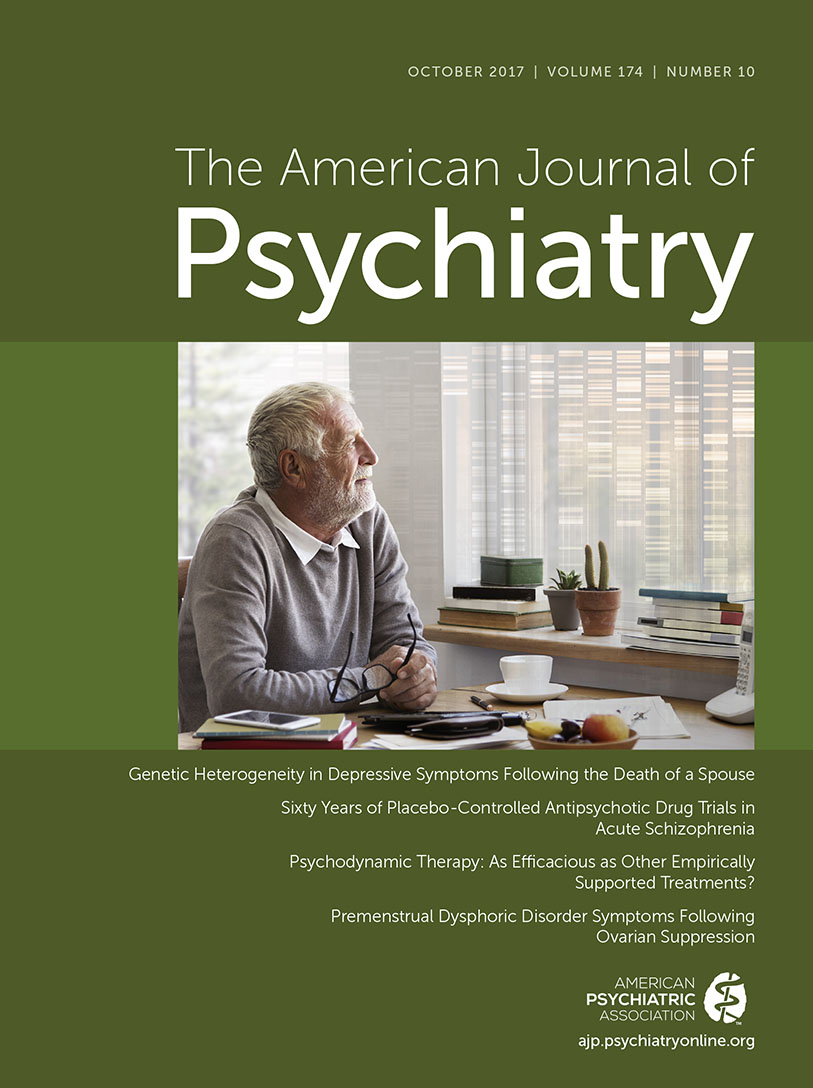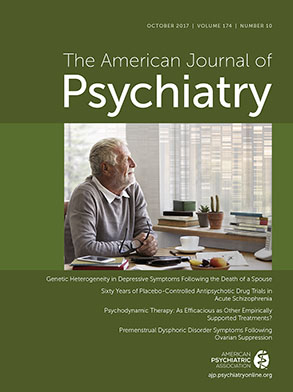The times they are a-changin’.
—Bob Dylan
In the seminal study by Schmidt et al. (
1), the authors tested the hypothesis that the acute change in ovarian steroid levels versus stable levels of ovarian steroids above a critical threshold triggered symptoms of premenstrual dysphoric disorder (PMDD) after gonadotropin-releasing hormone (GnRH) ovarian suppression. They found that it was the change in levels of estradiol and progesterone from low to high, and not the steady-state levels, that was associated with the onset of PMDD symptoms. The findings have important clinical and theoretical implications not only for understanding the pathophysiology and treatment of PMDD, but also for brain function in its adaptive versus nonadaptive response to internal and external perturbations.
The investigators studied 22 women, ages 30–50 years, with PMDD, diagnosed by using DSM-IV criteria, prospectively confirming the timing and severity of mood symptoms over 3 months by means of a four-item visual analog scale for irritability—one of the most predominant premenstrual complaints before and after 40 years of age (
2)—sadness, anxiety, and mood swings. After 2–3 months of GnRH-agonist-induced ovarian suppression with monthly injections of 3.75 mg of leuprolide, which after an initial stimulation suppresses ovarian function, 12 women who experienced symptom remission received 1 month of single-blind (participant only) placebo and then 3 months of continuous combined estradiol/progesterone. (Effects of estradiol versus progesterone were not differentiated in this study.) Outcome on primarily mood measures was assessed by using rater and self-ratings on the Premenstrual Tension Scale (
3). Scores on these scales increased (the participants were more symptomatic) during the first month of estradiol/progesterone compared with all other months (last month of leuprolide alone, placebo, second and third months of estradiol/progesterone), and there were no significant differences in symptom severity scores (self or rater) between the last month of leuprolide and the placebo month or the second or third month of estradiol/progesterone, nor between the second and third months of estradiol/progesterone treatment, demonstrating that it was the dynamic hormonal events (i.e., the changing ovarian hormone levels), rather than the prolonged exposure to a threshold level of ovarian steroids, that was critical in triggering PMDD symptoms.
Although of different timing and magnitude, other examples of the brain responding to changes rather than amplitude—of ovarian steroids, other neuroendocrine hormones, or other internal or external stimuli (
zeitgebers)—to elicit affective or behavioral changes abound: In women with PMDD and without PMDD, under the influence of progesterone in the luteal phase, melatonin circadian rhythms phase-delay (shift later) compared with the follicular phase, but only women with PMDD become symptomatic with this phase change in the luteal phase (
4). Correcting the timing disturbance between melatonin and sleep by shifting the timing of melatonin by means of critically timed bright light interventions, or shifting the timing and duration of sleep by using wake therapy, improves mood in PMDD (
4–
6). In antenatal depression the increase of ovarian steroids, and in postnatal depression the decrease in ovarian steroids, is associated with the precipitation of mood symptoms in susceptible individuals (
7). During the perimenopause, the increased onset and recurrence of mood disorders occurring then is associated with the change in reproductive hormonal status (
8).
This phenomenon of neuroendocrine change eliciting mood and behavioral change also characterizes other hormonal systems and internal and external
zeitgeber perturbations in other mood disorders. For example, in seasonal affective disorder the decrease in photoperiod (day length) during the winter, which elicits an increase in melatonin production that suppresses the hypothalamic-pituitary-gonadal axis in seasonally breeding species (
9), in humans may trigger the onset of a major depressive episode in vulnerable individuals, particularly women during times of more rapidly changing photoperiods (
10). Changing the decreased duration of the photoperiod either naturally, with the increased duration of photoperiod associated with the spring and summer months, or by administering bright light at critical times elicits antidepressant responses (
11).
The distinct contribution of the study by Schmidt and colleagues, however, is to distinguish that at least in women with PMDD, it is the acute change in ovarian steroids, not the altered amplitude, that elicited the depressive mood changes. That distinction remains to be made with other hormonal, neuroendocrine, or zeitgeber signals, a challenging task indeed given the rigor and specific challenge paradigms employed by Schmidt et al. to test their hypotheses.
The mechanisms by which the acute perturbations in ovarian steroids elicit mood changes and why PMDD symptom recurrence is self-limited, with symptoms remitting despite continuing stable ovarian steroid levels (in subsequent months after the estradiol/progesterone addback), remain elusive. Perhaps relevant to the acute change in ovarian steroids in some women with PMDD is the suggestion by McEwen that in response to stress, epigenetic changes in brain circuitry occur, eliciting physiological responses that with allostasis can lead to adaptation, but that with a repeated dysregulated stress response lead to pathophysiology (
12).
Modifying variables affecting response to neuroendocrine change may include, in addition to vulnerability for mood disorder, genetic predisposition and age. In the Schmidt et al. study, it would be helpful to know about the family history of mood disorder (in the responders versus nonresponders to the leuprolide and estradiol/progesterone interventions in women with PMDD) and whether symptom provocation during estradiol/progesterone addback (seven of 12 women) was a function of age, although there was a limited range in this study (30–50 years) and age did not distinguish leuprolide responders and nonresponders. Depressed individuals may behave more like aging individuals in their response to acute neuroendocrine changes. In the symptomatic luteal phase, but not the asymptomatic follicular menstrual cycle phase, women with PMDD, but not healthy comparison women, demonstrate a blunted response to light-induced phase shifts (
13). Age affects light-induced phase shifting in behavioral rhythms in mice (
14), although this effect has not been demonstrated in humans (
15). Depressed, compared with healthy, elderly individuals, in response to the probe of sleep deprivation, have a more protracted course of recovery sleep that compromises the augmentation of sleep continuity and slow wave (restorative) sleep, reflecting an impaired recovery or reversal of sleep, perhaps analogous to the slower adaptation of hormonal change in some women with PMDD (
16). The rapidity and duration of the cortisol response to a circadian signal also is affected by both age and gender (
17). As Eastman has demonstrated in shift workers, although “squashing” the amplitude of the circadian temperature rhythm with bright artificial light produced a faster phase shift than “nudging” it, it occurred at the cost of increased fatigue and greater mood disturbance (
18).
These observations have treatment implications: As in clinical practice, to allow certain patients to adapt to changes in medications, it is advisable to “start low and go slow” (referring to starting at a low dose and titrating upward gradually). Perhaps in women with PMDD a more gradual change in ovarian steroids might mitigate the provocation of symptoms elicited by acute changes, as does a dawn simulator (mimicking the gradual increase in light intensity at sunrise) in some patients with seasonal affective disorder (
19). This approach may serve to shift the allostatic load toward adaption rather than pathogenesis. As in Aesop’s Fable “The Tortoise and the Hare,” the tortoises among us may just need more time to get to our destination!
Acknowledgments
The author thanks Fernando Martinez, B.A., for help with the references.

